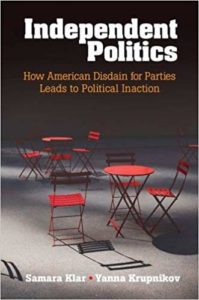
BOOK REVIEW: INDEPENDENT POLITICS
Independent Politics, How American Disdain for Parties Leads to Political Inaction, by Samara Klar and Yanna Krupnikov, 2016. Cambridge U. Press, 200 pages.
Ballot Access News, 1 September 2018
Re-printed in full with permission.

The authors are political scientists. Klar is at the University of Arizona and is a registered Democrat. Krupnikov is at Stony Brook University and is a registered independent. In 2017, the book received the Best Book Award from the American Political Science Association’s Experimental Politics Section; it also won the Robert E. Lane Award for best book from the APSA’s Political Psychology Section.
In 1992, six political scientists published research on independent voters. That book was The Myth of the Independent Voter. It showed that a large majority of people who said they were independents actually strongly prefer either the Democcratic Party or the Republican Party. These people were termed “leaners.” At the time, 40% of the public said they were independents, but the book established that true independents were closer to 5%.
Since 1992, new research has mostly confirmed the findings of Myth. In 2012, a paper, “Revisiting the Myth of the Independent Voter” concluded that little had changed since 1992. Klar and Krupnikov decided to research why so many people say they are independent, when they are not. The authors spent four years doing psychology experiments to help solve the puzzle. Their book presents their findings. The key finding is that “people who misrepresent their partisanship do so because they believe that openly identifying as a partisan will make a negative impression on others.” This is especially true for individuals who try to make a good impression on others. The research shows that a considerable share of the population does not care much about making a a good impression, although most people do care.
Because hidden partisans want to remain hidden, they abstain from engaging in discussions about politics, and the authors believe that society suffers as a result. Chapters One and Two set forth the book’s findings. The experiments are explained in Chapters Three through Seven.
The key experiment in chapter Three asks individuals how they could make the best possible impression, when they reveal their stance on political parties. Those respondents said the best way to make a good impression is to label oneself an independent. Other respondents were asked how they could make the worst possible impression, and they revealed that the
worst impression is made when one identifies publicly as a strong partisan of one party. This is especially true if, before being asked any questions, the respondents are given a newspaper story to read about current U.S. politics.
The experiments in chapter Four show that individuals do not want a new co-worker who is known to be a supporter of any particular party, even if that co-worker supports the same party as the respondent. These chapters also show that individuals do not want to live in neighborhoods in which some of their neighbors display signs showing support for a partisan candidate or a party. Individuals even find other individuals less attractive when they learn that the person whose picture they are looking at is a supporter of a party. In short, being identified with a party these days is “social suicide.” This is especially true when respondents read a newspaper story about politics before participating.
Chapter Five describes an experiment in which bumper stickers and other relatively small stickers were handed out on campus. Researchers then followed the individuals who had accepted the stickers. Whereas the non-partisan stickers, referring to issues, were likely to be displayed, the stickers referring to a party tended not to be displayed.
Chapter Six sets for the findings that, because identifying with a particular party has become so socially undesirable, fewer and fewer individuals are willing to talk about politics with their friends and neighbors. The authors fear that this is a problem for society.
Chapter Seven has the most surprising results. This is the chapter that shows that “closet partisans” are just as eager as open partisans for their favored political party to persevere when policy is set. It shows that closet partisans are upset when their own favored party compromises. Chapter Seven also presents experiments that show closet partisans are just as ideological as open partisans.
Chapter Eight makes the case that partisanship has actually decreased in recent years, among the public. However, the book was published in 2016, and things may have changed since then.
The book would have been stronger if it had done research into the contrast between how voters self-identify to pollsters, and how they register to vote, in the states that ask voters to describe themselves on voter registration forms. Although polls report that between 40% and 44% of voters identify as independents, only 28.5% register as independents. It would have been valuable if the authors had asked self-identified independents who register into parties to explain the divergence.
The book would also have been better if it had studied public opinion about the very concept of political parties, and whether many or all elections should become non-partisan. The authors, like virtually all social scientists, believe political parties are beneficial. They write, “Political parties are considered the backbone of the American democratic process, the sorting mechanism by which voters’ preferences are translated into policy outcomes…Partisan debate is widely considered to be an important component of any healthy democracy.”
Ballot Access News Subscription Page ($16 a Year)
 ROBERT STEELE: Goddess Cynthia McKinney and I (note the white guy at the back of the bus here, she will always be in front), when we founded #UNRIG, agreed that people not parties, truth not lies, authenticity not posturing, and inclusiveness not division, were needed to Make America Great Again. Donald Trump has done brilliantly against the 1%, less so in connecting with and mobilizing the 99% including the 73% that did not vote for him in 2016. I predict he will continue to surprise, particularly once a truth channel is created (picture TIME Magazine bought for $20M and renamed TRUMP; NBC selling the 7 pm time slot while we take the top four people away from Fox starting with Carlson and Kennedy, and of course a new protected social ecology that 200 million can opt in to that a) guarantees no censorship, manipulation, or digital assassination and b) guarantees the President will “hear” everyone's voice via presidential dashboard that visualizes all Trumpets (death to Twitter), emails (CodeMail?), videos (Bitchute), shared files, and more. Donald Trump is a force of nature. The times they are a'changing.
ROBERT STEELE: Goddess Cynthia McKinney and I (note the white guy at the back of the bus here, she will always be in front), when we founded #UNRIG, agreed that people not parties, truth not lies, authenticity not posturing, and inclusiveness not division, were needed to Make America Great Again. Donald Trump has done brilliantly against the 1%, less so in connecting with and mobilizing the 99% including the 73% that did not vote for him in 2016. I predict he will continue to surprise, particularly once a truth channel is created (picture TIME Magazine bought for $20M and renamed TRUMP; NBC selling the 7 pm time slot while we take the top four people away from Fox starting with Carlson and Kennedy, and of course a new protected social ecology that 200 million can opt in to that a) guarantees no censorship, manipulation, or digital assassination and b) guarantees the President will “hear” everyone's voice via presidential dashboard that visualizes all Trumpets (death to Twitter), emails (CodeMail?), videos (Bitchute), shared files, and more. Donald Trump is a force of nature. The times they are a'changing.
See Especially:
Steele, Robert with Cynthia McKinney, “Former Representative and Intelligence Official Team Up to Unrig Elections,” Independent Voter Network, 26 September 2017.
Robert Steele: Concept for Trump Triumph in 3 Moves UPDATE 5 Trump 2.0
Robert Steele: Core Works UPDATED with 21st Century University
See Also:
Steele, Robert with Javad Heirannia, “Trumpism is a form of populism,” Tehran Times, 2 June 2018.
Steele, Robert. “Peace in the Middle East: Denuclearizing Israel, Restoring Palestine, and More,” Russian International Affairs Council, 18 May 2018. PBI Back-Up
Steele, Robert, “How The Deep State Controls Social Media and Digitally Assassinates Critics: #GoogleGestapo – Censorship & Crowd-Stalking Made Easy,” American Herald Tribune, 7 November 2017.



